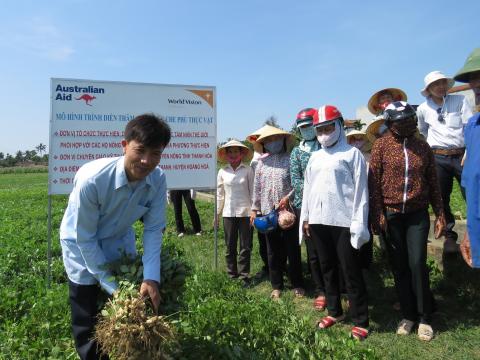Improved peanut cultivation techniques benefit poor farmers

Vien Thi Doc, who in her 40's, is happy with her peanut harvest in the northern province of Thanh Hoa.
“The yield has increased to 200 kilograms, up from 150 kilograms in the previous crop. My income has risen by at least 1.5 million dong (USD $69) per sao (500sqm). I have saved expenses for 20 working days, and one kilograms of seed,” she says proudly. “With other savings, I can send more money to my child studying at university in Hanoi.”
Like many others in coastal areas of Quang Xuong district, she struggled with unproductive farming, even though agriculture is the main income source (45%).
Their cultivation land is small, with the majority being degraded and intruded with salt or aluminium. Local farmers don’t have enough water for their plants because of a poor irrigation system. Their cultivation techniques are also unsustainable.
Fortunately, Vien learned some new farming techniques.
She adopted a mulching technique to cover the peanuts with straw or plant debris. This model allows farmers to keep soil moist, increase humus, and use less seeds. The yield is higher as farmers use micro-organic fertilizer rather than chemical fertilizer. Even better, this method reduces greenhouse gases as famers use the straw to mulch instead of burning it.
Vien is happy with her peanut harvest at her field in Thanh Hoa.
The technique is among many efforts that the World Vision-implemented Coastal Areas of Thanh Hoa Province Resilient to Natural Disasters (CATREND) grant project has made to help local farmers generate more income and adapt to climate change.
Under the project, Vien, other villagers, and the commune and district leaders have participated in training courses and field-day workshops on the technique since early 2015.
“The model doesn’t require complicated techniques and large amount of investment but the yield can be 1.5 times higher. I’ll tell others about the model and provide them with technical support,” says Nguyen Dang Hoan, a farmer from Hoang Hoa district.
Le Huy Cuong, head of agriculture department in the district, says, “The model helps our farmers cut down their production costs, improve soil fertility, and increase their income, which is sustainable and adaptive to climate change. We hope those living outside CATREND project’s working areas can apply the technique as well.”
The CATREND project aims to reduce impact of natural disaster under climate change’s effects for communities in Thanh Hoa province. The project lasts from 2011 till 2016 and benefits more than 73,000 people in Quang Xuong and Hoang Hoa districts. It’s funded by the Australia Department of Foreign Affairs and Trade (DFAT).
Photos and Vietnamese text: Le Quang Dao